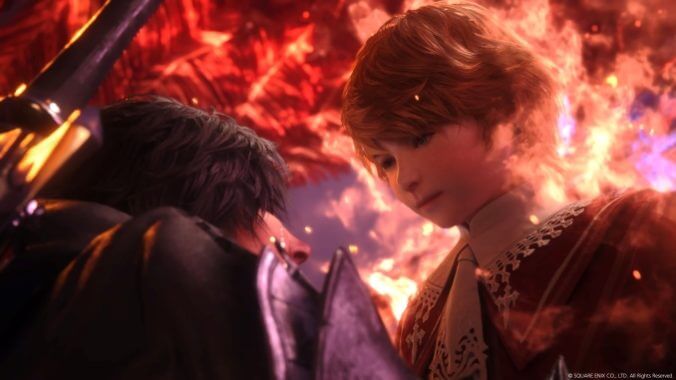
Final Fantasy 16 is heretical. Its prologue alone, a work so clearly in the mold of Game of Thrones more than anything from its own storied lineage, feels… difficult. These perceivable differences have stirred up discourse before the game’s even out. It’s gotten to the point where as of this writing, people have been actively debating what it means to be a Final Fantasy title, namely because naysayers have been looking for any reason to decry the game before getting to fully experience it. I’m not here to evangelize it, and I’m not going to because there are deviations it takes that simply don’t work for me, clear steps away from what has made this series work. But on the way, this moonshot does land itself among some stars that shine particularly bright. And so to the question of “What is a Final Fantasy,” I say this and whatever else dares to wear the moniker and try something, regardless of whether it connects or doesn’t. We don’t own it, but we can work through it.
Taking place at a tumultuous time in the history of Valisthea, Final Fantasy 16 follows Clive Rosfield from his adolescence and into his thirties as he fights to carve out a new world. Though he begins on a journey for personal revenge, his horizons are eventually broadened by the timely intervention of Cid Telamon, a revolutionary hellbent on bettering the situation of Bearers, people of Valisthea who are born with magical abilities only to be foisted off into domestic slavery or serve on the frontlines of a war that’d uphold the institutions that put them there. The state of the realm is, in a word that the cast of Final Fantasy 16 loves to throw out there, “fucked.” Along the way, Clive is reunited with faces he thought long gone, like his childhood friend Jill, and meets new ones, like Cid’s chief scout Gav, who bolster Clive’s spirits and party as he embarks on a quest across the length of Valisthea that has shades of Final Fantasy 7‘s environmentalist themes albeit in a new skin.
Valisthea, though housed in the shell of a game a far cry from what Final Fantasy fans are intimately familiar with, is a deliberate throwback to a medieval fantasy world after some years playing in worlds that have blended settings, and even timelines, and in that regard at least feels partly fresh. Characters joke about the impossibility of flight, mocking the notion of an ancient civilization having anything resembling an “airship,” and thus the towns and villages you come across are small and homely. Dotting the countryside between major destinations like Oriflamme, the capital of the Holy Empire of Sanbreque, and Kanver, these villages make up the breadth of the world of Valisthea and its people. This is at once a disappointing part of Final Fantasy 16, which spends a lot of time talking about the capitals of the world and the forces that govern from those perches, and a boon in disguise. As I can’t speak to what the game isn’t, I can instead say that though the stories of these regions begin in simple places, they are elevated by a lot of the side material that really reckons with the reality of materially changing the makeup and ideology of nations built on prejudices and cruelty, even when it isn’t beneficial to them. That being said, it would’ve been great to get an actual sense for places like Twinside, which instead become spectacular backdrops for run-of-the-mill dungeons that fill the climactic moments of the story and fall away from the focus of the story once you’re done there.
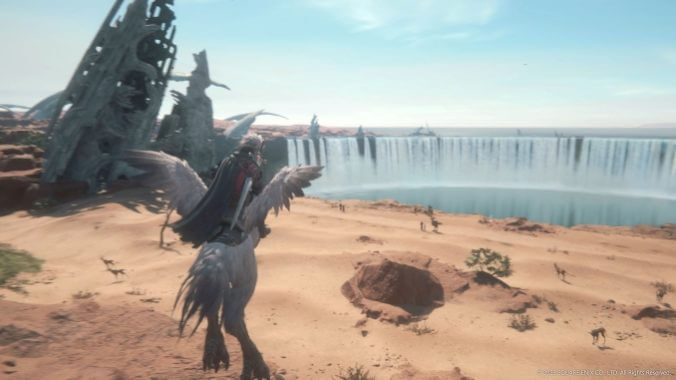
I think these explorations could’ve helped me shake off the feeling that I’d been to Valisthea before. Visually, the game is beautiful but artistically, many of the towns and regions you come to occupy, like Dalimil in the Dhalmekian Republic or Eastpool in Rosaria, feel lacking in identity beyond “town in a desert” or “foggy town.” The occasional skybox and landmark reminds me of the kind of awe Final Fantasy settings tend to inspire, but I’ll be damned if FF16 doesn’t make you work for those kinds of sights. The setting never quite comes alive as its own until a development in the story—the same one I briefly mentioned moments ago that stirs up certain plotlines—forces it into a reactive state that pulls together countless threads and impacts the realm in tangible ways. Even then, what shores up Final Fantasy 16 to me in these moments is its surprisingly strong cast of characters rather than a strong sense of place.
When you’re pulling from a property renowned for its various perspectives, it can probably be intimidating to feel like you have so much ground to cover and need to fill each second in those with arresting drama, but to FF16’s credit, not only is its central storyline compelling but its main players chew through scenes and whole arcs with ease. Whether it be Benedikta’s cruelty front and center, Cid’s casually sexy pirate swagger and radicalism, or Kupka’s utterly unhinged turn later in the game, FF16’s never missing for strong personalities to personify its themes of institutional violence and the fight for a world where people are allowed to live and die on their own terms. Our heroes, Clive and Jill, who are Dominants—people with the ability to summon and channel the abilities and strength of elemental deities—could have been wet blankets but instead spend a lot of their journey together reckoning with their own unwitting roles in the events that have led Valisthea to the point, often referring to themselves as monsters even if they were weapons honed and pointed at innocents by others. Side characters like Martha, a longtime ally to your cause of freeing Bearers, underscore how deeply FF16’s conflicts are felt outside of the main story, which slightly loses sight of its slave-freeing plot in its endgame in favor of the greater free will of man and a tyrannical god. It’s good dark fantasy fare and despite that, its characters come through with so much heart when this really grisly world is coming down on them and all they have is each other. Seeing a sense of camaraderie spark between Clive and the folks at the hideaway and then watching it grow over the years together is really lovely thing, especially when you get over the initial hump of thinking Clive’s anything other than a deeply tragic protagonist who was ripped out of his life directly after a traumatizing event.
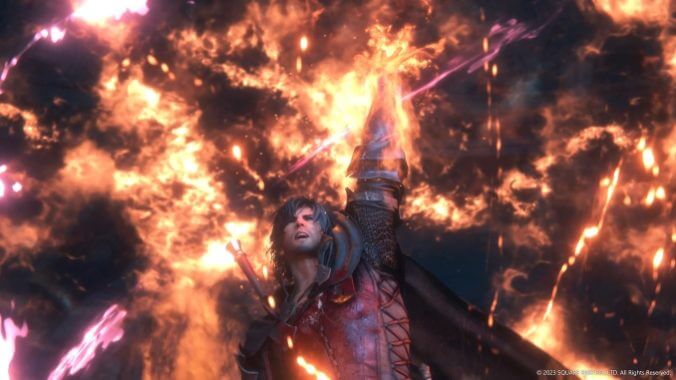
FF16’s strong characters don’t come without caveats though. For as bold as it clearly wants to be, FF16’s queer romance storyline—the very one that reportedly threatened its ability to be sold in Saudi Arabia—is a big swing and a miss; A real blink and you’ll miss it moment, which is disappointing considering the really explicit realization of so many other relationships in this game. Benedikta and Anabella both straddle the respective men of their life within the opening hours of this game in a move the developers clearly think is transgressive and boundary-pushing, but the gay lovers have to settle for tearful exchanges and longing glances? In 2023? And speaking of the women of FF16, much noise has been, I think rightfully, made about how the villainous women at the outset of the game are such tiring embodiments of the characterization of evil and sexy women. It’s a dynamic only made more frustrating and blatant by the chaste nature of the women FF16 would put on the other side of the moral spectrum from them outside of perhaps one (obvious) exemption. Benedikta, a character I found compelling to begin with, especially suffers a fate that only dated writing could barely excuse. And of course, there’s the lack of prominent people of color that the team frustratingly waved away early on. Hey, even though they aren’t a major player, shoutout to L’ubor, a definitely Brown guy I enjoyed meeting in the game. Shame they tried to hide him for some reason.
Even if Valisthea suffers from shortcomings, FF16’s other half, consisting of you carving your way across it, rarely does. In a move that I’m sure has ruffled some feathers, FF16’s greatest deviation into a real time action-based RPG is its greatest success. Gone are the turns of yore, replaced now with a robust set of techniques for players to master and string together to their heart’s content. Unlike the Devil May Cry series, which FF16’s combat director has had a hand in, you will not be accruing ability points to spend on new combos beyond the introductory ones; Instead, players will unlock Eikons (summons from throughout the serie) at sensitive plot moments that will expand on Clive’s repertoire a handful of skills at a time. You can only ever have three Eikons equipped, with two combat abilities apiece as well as an Eikonic Feat, like a dash, block or the ability to charge an area-of-effect spell. Upgrading them will often increase the effects of the abilities and further investing in mastery will let players swap said ability between different Eikon loadouts, a welcome wrinkle as you begin amassing incredible powers and want to personalize your skillset. This system feels like the singular most RPG aspect of the game as you truly get to make Clive’s powerset your own and there’s a great joy in experimenting with the possibilities to maximize damage and graft your playstyle onto the character. I, a guy who loves to cover most of his bases, ultimately settled for a jack of all trades kind of build that allowed me to parry projectiles and close-quarters blows alike, do massive crowd control damage, and have great maneuverability around the battlefield. Another player could decide to spec into an offensive spell with healing potential or a whole host of sentry/protection spells. Especially as there is a stagger meter on most enemies, and thus a window to maximize damage, I’m curious how other players find combos of these abilities that juice those numbers really high.
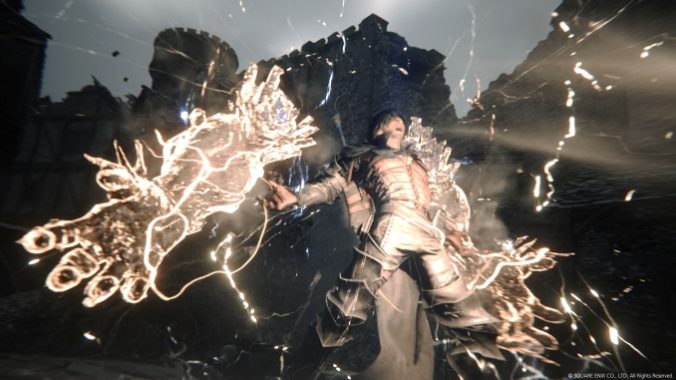
It’s a shame that this is about as intensely as FF16 wades into being a traditional RPG, because as someone who often ignores the endless menus full of tiny optimizations, personalizations, and mods until it starts killing me to not engage with it, I was fully ready to jump into this game and tweak the hell out of it. Charms that you find in shops and throughout the world offer a morsel of this, often affecting the potency of potions or individual abilities, but it’s not quite enough. To add insult to injury, the addition of crafting and the breakdown of weapons and armor into colored hierarchies denoting rarity and power seemingly makes no sense. Often enough, I’d have purple gear (regularly the mark of legendary equipment) that I’d upgraded be supplanted by a random low level green weapon that was two reinforcements from dwarfing it completely. I rarely even needed to go to the blacksmith, really only stopping in when the plot demanded I be back at the hideaway, which is surprising how the game drowns you in crafting materials second only to gil and XP. Though crafting ends up feeding into the Hunt Board, a generally fun distraction that inspired quite a bit more play from me than I expected, it also feels like it lets down that aspect of the game with hollow rewards that fail to be greater than a reskinned sword with bigger numbers.
Final Fantasy 7 Remake just had a wonderful weapon system a few years ago that encouraged players to use conventional and unusual weapons alike in order to gain proficiency enough with their designated ability for your character to learn them permanently, and it feels like anything involved like that was just completely axed from this part of FF16. I couldn’t tell you why you should necessarily put the hard work into grinding for a technically better sword when a clever enough deployment of magical abilities and decent enough weapon could do the same job, and that’s disappointing to report. You can so clearly see where a successful action game here was forced back into the likeness of a thing it really isn’t, but felt obliged to be: a full-blown RPG.
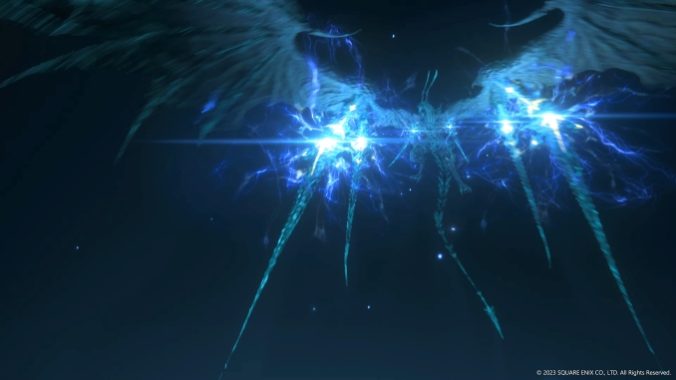
FF16 fumbles the small things, but how does it do with the exceptionally large, you might be asking. As of my last preview, I was cautiously hesitant about the Eikon fights that have made up a significant part of the marketing of the game. With two down and countless more to go in the full game, I was dreading having control wrested from me in order to be spoon fed empty, if technically impressive, showcases that also functioned as avenues to hear Masayoshi Soken’s incredible score. Though there are still a number of these encounters—where Clive becomes the famous Final Fantasy summon Ifrit and does titanic battle with other summons—that are on rails, they mostly give way to more freeform brawls that feel leagues more satisfying than drawn out quick time sequences. The best of these finds the balance between both schools of thought to deliver a frankly insane fight by Final Fantasy standards that tries to be a microcosm of something like Sephiroth’s protracted Supernova animation for the modern generation. It’s wild, but more importantly it works better than the game’s earliest Eikon fights.
And that’s just the thing about Final Fantasy 16: it’s not short of reasons to be hesitant about it, but despite them, it sings better than you might think. The story may suffer from the classic Final Fantasy dilemma of tackling a lot of characters and trying to find a time and place for them all, but also holds nothing back in regards to its main themes along the way. The developers may stumble on their way to realizing a fully diverse cast, but that cast is also hugely talented and commands their scenes when needed, bringing layers to characters that could’ve been afterthoughts or simple fodder. Even when Final Fantasy 16 turns away from most of the systems that would make it a compelling and tactical RPG, it embraces a deeply rewarding combat system that lets it be expressive in its own way entirely. It’s a button-mashing, occasionally awkwardly sexed-up and mature action game that seems at least a bit ashamed to fully be an RPG, opting instead to fill the space those systems would occupy with timed button prompts a decade out of touch and endless spectacles. It is, at once, this cosmically confused product on one hand, and the most self assured thing on the other. In other words, it’s an RPG fitting of the era.
Moises Taveras is the assistant games editor for Paste Magazine. He was that one kid who was really excited about Google+ and is still sad about how that turned out.